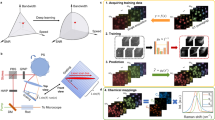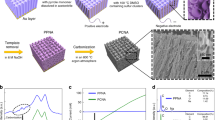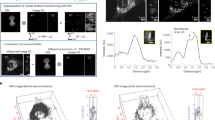Abstract
Super-resolution imaging of cell metabolism is hindered by the incompatibility of small metabolites with fluorescent dyes and the limited resolution of imaging mass spectrometry. We present ultrasensitive reweighted visible stimulated Raman scattering (URV-SRS), a label-free vibrational imaging technique for multiplexed nanoscopy of intracellular metabolites. We developed a visible SRS microscope with extensive pulse chirping to improve the detection limit to ~4,000 molecules and introduced a self-supervised multi-agent denoiser to suppress non-independent noise in SRS by over 7.2 dB, resulting in a 50-fold sensitivity enhancement over near-infrared SRS. Leveraging the enhanced sensitivity, we employed Fourier reweighting to amplify sub-100-nm spatial frequencies that were previously overwhelmed by noise. Validated by Fourier ring correlation, we achieved a lateral resolution of 86 nm in cell imaging. We visualized the reprogramming of metabolic nanostructures associated with virus replication in host cells and subcellular fatty acid synthesis in engineered bacteria, demonstrating its capability towards nanoscopic spatial metabolomics.
This is a preview of subscription content, access via your institution
Access options
Access Nature and 54 other Nature Portfolio journals
Get Nature+, our best-value online-access subscription
27,99 € / 30 days
cancel any time
Subscribe to this journal
Receive 12 print issues and online access
269,00 € per year
only 22,42 € per issue
Buy this article
- Purchase on SpringerLink
- Instant access to full article PDF
Prices may be subject to local taxes which are calculated during checkout





Similar content being viewed by others
Data availability
Example datasets for FURNACE and spectral unmixing are available at the Cheng Lab GitHub page (https://github.com/buchenglab). Larger raw datasets are available on figshare60.
Code availability
All relevant code, including NACE denoising, Fourier reweighting and spectral unmixing, can be accessed at the Cheng Lab GitHub page (https://github.com/buchenglab).
References
Sahl, S. J., Hell, S. W. & Jakobs, S. Fluorescence nanoscopy in cell biology. Nat. Rev. Mol. Cell Bio. 18, 685–701 (2017).
Betzig, E. et al. Imaging intracellular fluorescent proteins at nanometer resolution. Science 313, 1642–1645 (2006).
Rust, M. J., Bates, M. & Zhuang, X. W. Sub-diffraction-limit imaging by stochastic optical reconstruction microscopy (STORM). Nat. Methods 3, 793–795 (2006).
Hell, S. W. & Wichmann, J. Breaking the diffraction resolution limit by stimulated-emission — stimulated-emission-depletion fluorescence microscopy. Opt. Lett. 19, 780–782 (1994).
Gustafsson, M. G. L. Surpassing the lateral resolution limit by a factor of two using structured illumination microscopy. J. Microsc. 198, 82–87 (2000).
Giesen, C. et al. Highly multiplexed imaging of tumor tissues with subcellular resolution by mass cytometry. Nat. Methods 11, 417–422 (2014).
Morato, N. M. & Cooks, R. G. Desorption electrospray ionization mass spectrometry: 20 years. Acc. Chem. Res. 56, 2526–2536 (2023).
Ma, S. Y. et al. High spatial resolution mass spectrometry imaging for spatial metabolomics: advances, challenges, and future perspectives. Trends Anal. Chem. 159, 116902 (2023).
Johnson, C. H., Ivanisevic, J. & Siuzdak, G. Metabolomics: beyond biomarkers and towards mechanisms. Nat. Rev. Mol. Cell Bio. 17, 451–459 (2016).
Alexandrov, T. Spatial metabolomics: from a niche field towards a driver of innovation. Nat. Metab. 5, 1443–1445 (2023).
Zumbusch, A., Holtom, G. R. & Xie, X. S. Three-dimensional vibrational imaging by coherent anti-Stokes Raman scattering. Phys. Rev. Lett. 82, 4142–4145 (1999).
Freudiger, C. W. et al. Label-free biomedical imaging with high sensitivity by stimulated raman scattering microscopy. Science 322, 1857–1861 (2008).
Zhang, D. L. et al. Depth-resolved mid-infrared photothermal imaging of living cells and organisms with submicrometer spatial resolution. Sci. Adv. 2, e1600521 (2016).
Yonemaru, Y. et al. Super-spatial- and -spectral-resolution in vibrational imaging via saturated coherent anti-stokes raman scattering. Phys. Rev. Appl. 4, 2676–2681 (2015).
Singh, A. K., Santra, K., Song, X. Y., Petrich, J. W. & Smith, E. A. Spectral narrowing accompanies enhanced spatial resolution in saturated coherent anti-Stokes Raman scattering (CARS): comparisons of experiment and theory. J. Phys. Chem. A 124, 4305–4313 (2020).
Gong, L., Zheng, W., Ma, Y. & Huang, Z. W. Saturated stimulated-Raman-scattering microscopy for far-field superresolution vibrational imaging. Phys. Rev. Appl. 11, 034041 (2019).
Würthwein, T., Irwin, N. & Fallnich, C. Saturated Raman scattering for sub-diffraction-limited imaging. J. Chem. Phys. 151, 194201 (2019).
Gong, L., Zheng, W., Ma, Y. & Huang, Z. W. Higher-order coherent anti-Stokes Raman scattering microscopy realizes label-free super-resolution vibrational imaging. Nat. Photonics 14, 115–122 (2020).
Fu, P. C. et al. Super-resolution imaging of non-fluorescent molecules by photothermal relaxation localization microscopy. Nat. Photonics 17, 330–337 (2023).
Lv, X. B., Gong, L., Lin, S. L., Jin, P. & Huang, Z. W. Super-resolution stimulated Raman scattering microscopy with the phase-shifted spatial frequency modulation. Opt. Lett. 47, 4552–4555 (2022).
Guilbert, J. et al. Label-free super-resolution chemical imaging of biomedical specimens. Adv. Imaging 1, 011004 (2024).
Fantuzzi, E. M. et al. Wide-field coherent anti-Stokes Raman scattering microscopy using random illuminations. Nat. Photonics 17, 1097–1104 (2023).
Qian, C. X. et al. Super-resolution label-free volumetric vibrational imaging. Nat. Commun. 12, 3648 (2021).
Shi, L. X. et al. Super-Resolution vibrational imaging using expansion stimulated raman scattering microscopy. Adv. Sci. 9, 2200315 (2022).
Jang, H. et al. Super-resolution SRS microscopy with A-PoD. Nat. Methods 20, 448–458 (2023).
Bi, Y. L. et al. Near-resonance enhanced label-free stimulated Raman scattering microscopy with spatial resolution near 130 nm. Light Sci. Appl. 7, 81 (2018).
Xiong, H. Q. et al. Stimulated Raman excited fluorescence spectroscopy and imaging. Nat. Photonics 13, 412–417 (2019).
Xiong, H. Q. et al. Super-resolution vibrational microscopy by stimulated Raman excited fluorescence. Light Sci. Appl. 10, 87 (2021).
Shou, J. W. et al. Super-resolution vibrational imaging based on photoswitchable Raman probe. Sci. Adv. 9, eade9118 (2023).
Ao, J. et al. Photoswitchable vibrational nanoscopy with sub-100-nm optical resolution. Adv Photonics 5, 066001 (2023).
Buzzard, G. T., Chan, S. H., Sreehari, S. & Bouman, C. A. Plug-and-play unplugged: optimization-free reconstruction using consensus equilibrium. SIAM J. Imaging Sci. 11, 2001–2020 (2018).
Müller, C. B. & Enderlein, J. Image scanning microscopy. Phys. Rev. Lett. 104, 198101 (2010).
Dertinger, T., Colyer, R., Vogel, R., Enderlein, J. & Weiss, S. Achieving increased resolution and more pixels with superresolution optical fluctuation imaging (SOFI). Opt. Express 18, 18875–18885 (2010).
Koho, S. et al. Fourier ring correlation simplifies image restoration in fluorescence microscopy. Nat. Commun. 10, 3103 (2019).
Dabov, K., Foi, A., Katkovnik, V. & Egiazarian, K. Image denoising with block-matching and 3D filtering. In Proc. SPIE 6064, Image Processing: Algorithms and Systems, Neural Networks, and Machine Learning 6064, 606414 (SPIE, 2006).
Krull, A., Buchholz, T. O. & Jug, F. Noise2Void-learning denoising from single noisy images. In Proc. IEEE IEEE/CVF Conference on Computer Vision and Pattern Recognition 2124–2132 (CVF, 2019).
Xu, J. et al. Noisy-as-Clean: learning self-supervised denoising from corrupted image. IEEE Trans. Image Process. 29, 9316–9329 (2020).
Weigert, M. et al. Content-aware image restoration: pushing the limits of fluorescence microscopy. Nat. Methods 15, 1090–1097 (2018).
Wang, Z., Bovik, A. C., Sheikh, H. R. & Simoncelli, E. P. Image quality assessment: From error visibility to structural similarity. IEEE Trans. Image Process. 13, 600–612 (2004).
Boyd, R. W. Nonlinear Optics 4th edn (Academic Press, 2020).
Rossignol, E. D., Peters, K. N., Connor, J. H. & Bullitt, E. Zika virus induced cellular remodelling. Cell Microbiol. 19, e12740 (2017).
Miron, E. et al. Chromatin arranges in chains of mesoscale domains with nanoscale functional topography independent of cohesin. Sci. Adv. 6, eaba8811 (2020).
Li, P. et al. The RNA polymerase of cytoplasmically replicating Zika virus binds with chromatin DNA in nuclei and regulates host gene transcription. Proc. Natl Acad. Sci. USA 119, e2205013119 (2022).
Tan, Y., Lin, H. & Cheng, J.-X. Profiling single cancer cell metabolism via high-content SRS imaging with chemical sparsity. Sci. Adv. 9, eadg6061 (2023).
Saxena, N. & Chandra, N. C. Cholesterol: a prelate in cell nucleus and its serendipity. Curr. Mol. Med. 20, 692–707 (2020).
Lee, S. Y. et al. A comprehensive metabolic map for production of bio-based chemicals. Nat. Catal. 2, 18–33 (2019).
Xiao, Y., Bowen, C. H., Liu, D. & Zhang, F. Z. Exploiting nongenetic cell-to-cell variation for enhanced biosynthesis. Nat. Chem. Biol. 12, 339–344 (2016).
Tague, N. et al. Longitudinal single-cell imaging of engineered strains with stimulated raman scattering to characterize heterogeneity in fatty acid production. Adv. Sci. 10, 2206519 (2023).
Willdigg, J. R. & Helmann, J. D. Mini review: bacterial membrane composition and its modulation in response to stress. Front. Mol. Biosci. 8, 634438 (2021).
Lennen, R. M. et al. Membrane stresses induced by overproduction of free fatty acids in Escherichia coli. Appl. Environ. Microb. 77, 8114–8128 (2011).
Helmchen, F. & Denk, W. Deep tissue two-photon microscopy. Nat. Methods 2, 932–940 (2005).
Koike, K., Smith, N. I. & Fujita, K. Spectral focusing in picosecond pulsed stimulated Raman scattering microscopy. Biomed. Opt. Express 13, 995–1004 (2022).
Ceroni, F. et al. Burden-driven feedback control of gene expression. Nat. Methods 15, 387–393 (2018).
Wei, M. et al. Volumetric chemical imaging by clearing-enhanced stimulated Raman scattering microscopy. Proc. Natl Acad. Sci. USA 116, 6608–6617 (2019).
Lin, P. et al. Volumetric chemical imaging in vivo by a remote-focusing stimulated Raman scattering microscope. Opt. Express 28, 30210–30221 (2020).
Wassie, A. T., Zhao, Y. X. & Boyden, E. S. Expansion microscopy: principles and uses in biological research. Nat. Methods 16, 33–41 (2019).
Wei, L. et al. Super-multiplex vibrational imaging. Nature 544, 465–470 (2017).
Pylvänäinen, J. W. et al. Fast4DReg-fast registration of 4D microscopy datasets. J. Cell Sci. 136, jcs260728 (2023).
Kimling, J. et al. Turkevich method for gold nanoparticle synthesis revisited. J. Phys. Chem. B 110, 15700–15707 (2006).
Lin, H. Raw data for URV-SRS. figshare https://doi.org/10.6084/m9.figshare.26970583 (2024).
Acknowledgements
We thank C. A. Bouman for the discussion on the NACE denoising algorithm, N. Tague for the discussion on the bacterial fatty acid production results and L. Brown at BU-CMD for the help with antiviral compound curation. This work was supported by the Office of Science (BER) at the U.S. Department of Energy (DE-SC0019387 to M.J.D. and J.-X.C.), NIH R35 GM136223, R01 EB032391, R01 EB035429, R01 AI141439, R01 CA224275 to J.-X.C., R35 GM 118173 to J.A.P., Jr., and in part by grant number 2023-321163 from the Chan Zuckerberg Initiative DAF, an advised fund of Silicon Valley Community Foundation.
Author information
Authors and Affiliations
Contributions
H.L. and J.-X.C. conceived the project. H.L. and L.W. constructed the extensively chirped visible SRS system. H.L. developed and implemented the FURNACE algorithm. Y.T. prepared SKOV3 cells and performed NIR SRS experiments for ZIKV-infected VERO cells. S.S. and J.C. provided ZIKV-infected, mock and drug-treated VERO cells. G.D. performed noise correlation analysis. J.-B.L. and M.J.D. provided fatty acid-producing E. coli strains. H.H. provided the SJSA-1 cells with fluorescence staining. J.A.P., Jr. and T.J.R. synthesized and provided antiviral compounds. H.L. and J.-X.C. wrote the manuscript with inputs and approval from all authors. J.-X.C. and L.T. supervised the project.
Corresponding author
Ethics declarations
Competing interests
The authors declare no competing interests.
Peer review
Peer review information
Nature Methods thanks Natalie Belsey, Minbiao Ji, Dimitrios Tsikritsis and the other, anonymous, reviewer(s) for their contribution to the peer review of this work. Primary Handling Editor: Rita Strack, in collaboration with the Nature Methods team. Peer reviewer reports are available.
Additional information
Publisher’s note Springer Nature remains neutral with regard to jurisdictional claims in published maps and institutional affiliations.
Extended data
Extended Data Fig. 1 Phototoxicity of visible SRS on biological samples under different pulse durations.
(a) Damage threshold for three different cells under 4 different pulse chirping (duration) conditions. (b) SRS imaging (CH composite) of SKOV3 ovarian cancer cell with 0.15 ps laser at the power condition marked as the red asterisk in (a). Frames 1, 5 and 10 from 10 consecutive acquisitions are shown. Arrows show ionization photodamage and the circle indicate cell shrinkage induced by photodamage. 3 independent experiments were repeated with similar results.
Extended Data Fig. 2 Change of SRS signal intensity and off- resonance background under different pulse durations.
(a) Visible SRS imaging of pure DMSO for SRS peak signal-to- noise ratio (SNR) measurement. Peak signal is the mean pixel values in the foreground dashed box, while the noise is quantified as the standard deviation in the background dashed box (n = 400 pixels for both boxes). (b) PSNR under different pulse durations. Average on-sample powers were fixed to 10 mW for pump and 10 mW for Stokes. (c, d) Visible SRS imaging of SJSA-1 bone cancer cells at Raman on resonance (2930 cm−1) and off-resonance (2800 cm−1) under 2.5 ps and 4 ps chirping conditions. (e) Ratio between Raman on and off resonance signals in cells. Datapoints represent average values from individual cells. n = 7 for 2.5 ps condition and 5 for 4 ps condition.
Extended Data Fig. 3 Limit of detection (LOD) for NIR SRS and visible SRS under the biocompatible power limits.
(a) NIR SRS spectra of DMSO serial dilution in water. Peak intensities versus DMSO concentrations were plotted and linearly fitted along the sloped dotted line. LOD was calculated as the linear fitting concentration at baseline intensity + 3σ (horizontal dotted line value), where baseline intensities were the mean values at zero concentrations and σ were the noise levels measured as the standard deviation in a background area (n = 400 pixels). (b) Visible SRS measurements of the same samples, together with the linearity curve to benchmark the LOD. Values of the LOD are shown in corresponding linear fitting plots.
Extended Data Fig. 4 Calculation of excitation volume for visible and NIR SRS.
(a) Pump-probe signal of 30 nm AuNP using NIR and visible SRS. (b) Line profiles along the dotted lines in (a) with FWHM measurement. (c) Three-dimensional representation of the SRS PSF as a surface plot corresponding to the half of its maximum value. (d) DMSO detection limit for visible SRS and NIR SRS in terms of absolute number of molecules. Zoom-in of the shaded region on the top panel is shown on the bottom panel.
Extended Data Fig. 5 Example of NACE data generation and denoising performance.
(a) Examples of noisier images (z1, …, z4) and the noisy raw image (y) by changing the number of averaged frames. (b) Denoising of the raw image (y) using individual NACs and NACE. na, added noise; no, observed noise; nr, residual noise.
Extended Data Fig. 6 Validating the performance of NACE denoising using datasets with high-SNR baseline.
(a) Average of a 100-frame time sequence used as the ground truth. (b) Zoom-in of the dashed box in (a) with different number of averages, including 2, 4, 6, 8, 10 and 100. Measured noise levels are shown under each image. (c) Denoising of 10-average raw image using unsupervised/self- supervised denoiser (NACE, BM3D, N2V). (d) Quantification of denoising performance. Box plots (n = 5) show the structural similarity index (SSIM) and peak signal to noise ratio (PSNR) (the higher is better) between the raw, denoising outputs and the ground truth. The boxes indicate interquartile range (IQR), the red lines show medians, the black lines represent whiskers which extend to 1.5 times of the IQR, and the red data points are the outliers exceeding the whiskers. 3 independent experiments were repeated with similar results.
Extended Data Fig. 7 Imaging virus infected cells after antiviral compounds treatment.
(a) Example visible SRS images (at 2930 cm−1) of antiviral compounds treated (CMLD13694, CMLD13695, CMLD13697, and ΔE3L vaccinia), mock, and ZIKV-infected VERO cells. Arrows with ‘A’ and ‘N’ indicate example abnormal and normal cells, respectively. 3 independent experiments were repeated with similar results. (b) Stacked bar plots of the proportions of the abnormal and normal cells in each group. Scale bars, 10 µm.
Extended Data Fig. 8 Comparison between NIR SRS and URV-SRS imaging of virus replication sites.
(a) NIR SRS imaging of ZIKV-infected cells at 2930 cm−1. (b) URV-SRS imaging of ZIKV-infected cells at 2930 cm−1. (c) Zoom- in of a replication site in the dashed box in (a). (d–f) Zoom-in of a replication site in the dashed box in (b). Raw visible SRS image, NACE denoising output, and FURANCE resolution enhanced output are sequentially shown from (d) to (f). 4 independent experiments were repeated with similar results.
Extended Data Fig. 9 Comparing FURNACE with other deconvolution methods.
From left to right, Raw (y) SRS image, FURNACE output, Richardson-Lucy deconvolution (RL Deconv) output, and A-Pod output. 3 independent experiments were repeated with similar results.
Extended Data Fig. 10 Applying FURNACE to NIR SRS.
(a) Raw NIR SRS imaging of mammalian cells at 2930 cm−1. (b) Zoom-in of the cytoplasm (dashed box 1) and nucleus (dashed box 2) highlighted in (a). (c) The FURNACE output of the NIR SRS image in (a). (d) Zoom in on the highlighted regions in (c). (e) Line profiles between the two arrows in the cytoplasm (dashed box 1 in (b) and (d)). (f) Line profiles between the two arrows in the nucleus (dashed box 2 in (b) and (d)). 5 independent experiments were repeated with similar results.
Supplementary information
Supplementary Information
Supplementary Notes 1–12, Supplementary Table 1 and Supplementary Figs. 1–13.
Supplementary Video 1
Three-dimensional URV-SRS imaging of ZIKV infected Vero E6 cells at 2930 cm−1.
Rights and permissions
Springer Nature or its licensor (e.g. a society or other partner) holds exclusive rights to this article under a publishing agreement with the author(s) or other rightsholder(s); author self-archiving of the accepted manuscript version of this article is solely governed by the terms of such publishing agreement and applicable law.
About this article
Cite this article
Lin, H., Seitz, S., Tan, Y. et al. Label-free nanoscopy of cell metabolism by ultrasensitive reweighted visible stimulated Raman scattering. Nat Methods 22, 1040–1050 (2025). https://doi.org/10.1038/s41592-024-02575-1
Received:
Accepted:
Published:
Issue Date:
DOI: https://doi.org/10.1038/s41592-024-02575-1
This article is cited by
-
Capturing more than meets the eye
Nature Methods (2025)



